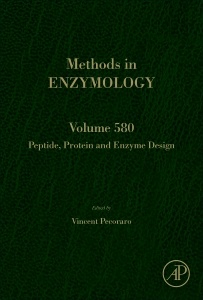Description
Peptide, Protein and Enzyme Design
Language: English
Subjects for Peptide, Protein and Enzyme Design:
Support: Print on demand
Description
/li>Contents
/li>Comment
/li>
De Novo Enzyme Design, the newest volume in the Methods in Enzymology series, continues the legacy of this premier serial with quality chapters authored by leaders in the field. This volume includes the design of metal binding maquettes, insertion of non-natural cofactors, Cu metallopeptides, non-covalent interactions in peptide assemblies, peptide binding and bundling, heteronuclear metalloenzymes, florinated peptides, De Novo imaging agents, and protein-protein interaction.
1. Chemical Post-Translational Modification with Designed Rhodium(II) Catalysts Samuel C. Martin, Matthew B. Minus and Zachary T. Ball 2. Cell Binding Assays for Determining the Affinity of Protein-Protein Interactions: Technologies and Considerations Sean Hunter and Jennifer Cochran 3. Protein and Antibody Engineering by Phage Display Julia C. Frei and Jonathan R. Lai 4. Incorporation of Unnatural Amino Acids into Proteins Expressed in Mammalian Cells Robert Serfling and Irene Coin 5. Method for Enzyme Design with Genetically Encoded Unnatural Amino Acids Cheng Hu and Jiangyun Wang 6. Methods for Solving Highly Symmetric De Novo Designed Metalloproteins: Crystallographic Examination of a Novel Three Stranded Coiled Coil Structure Containing D-Amino Acids Leela Ruckthong, Jeanne A. Stuckey and Vincent L. Pecoraro 7. SpyRings Declassified: A Blueprint for using Isopeptide-Mediated Cyclization to Enhance Enzyme Thermal Resilience Christopher Schoene, S. Paul Bennett and Mark Howarth 8. Engineering and Application of LOV2-Based Photoswitches Seth Parker Zimmerman, Brian Kuhlman and Hayretin Yumerefendi 9. Minimalist Design of Allosterically Regulated Protein Catalysts Olga V. Makhlynets and Ivan V. Korendovych 10. Combining Design and Selection to Create Novel Protein-Peptide Interactions Elizabeth B. Speltz, Nicholas Sawyer and Lynne Regan 11. Metal-Directed Design of Supramolecular Protein Assemblies Jake B. Bailey, Rohit H. Subramanian, Lewis A. Churchfield and F. Akif Tezcan 12. Designing Fluorinated Proteins E. Neil G. Marsh 13. Solid Phase Synthesis of Helically Folded Aromatic Oligoamides Simon J. Dawson, Xiaobo Hu, Stijn Claerhout and Ivan Huc 14. Conformational Restriction of Peptides Using Dithiol Bis-Alkylation Leila Peraro, Timothy R. Siegert and Joshua A. Kritzer 15. Engineering Short Pre-Organized Peptide Sequences for Metal Ion Coordination: Copper(II) a Case Study Luís M. P. Lima and Olga Iranzo 16. De Novo Construction of Redox Active Proteins C. C. Moser, M. M Sheehan, N. M. Ennist, G. Kodali, C. Bialas, M. T. Englander, B. M. Discher and P. L. Dutton 17. Design Strategies for Redox Active Metalloenzymes: Applications in Hydrogen Production Rafael Alcala-Torano, Dayn Joseph Sommer, Zahra Bahrami Dizicheh and Giovanna Ghirlanda 18. Equilibrium Studies of Designed Metalloproteins Brian R. Gibney 19. Reconstitution of Heme Enzymes with Artificial Metalloporphyrinoids Koji Oohora and Takashi Hayashi 20. Creation of a Thermally Tolerant Peroxidase Yoshihito Watanabe and Hiroshi Nakajima 21. Designing Covalently Linked Heterodimeric Four-Helix Bundles Marco Chino, Linda Leone, Ornella Maglio and Angela Lombardi 22. Design of Heteronuclear Metalloenzymes Ambika Bhagi-Damodaran,Parisa Hosseinzadeh, Evan Mirts, Julian Reed, Igor D. Petrik and Yi Lu 23. Periplasmic Screening for Artificial Metalloenzymes Markus Jeschek, Sven Panke and Thomas R. Ward 24. De Novo Designed Imaging Agents Based on Lanthanide Peptides Complexes Anna F. A. Peacock 25. Peptide Binding for Bio-Based Nanomaterials Nicholas M. Bedford, Catherine Munro and Marc R. Knecht
- Continues the legacy of this premier serial with quality chapters on de novo enzyme design
- Represents the newest volume in the Methods in Enzymology series, providing premier, quality chapters authored by leaders in the field
- Ideal reference for those interested in the study of enzyme design that looks at both structure and mechanism
These books may interest you

Peptides: Chemistry and Biology 105.49 €



